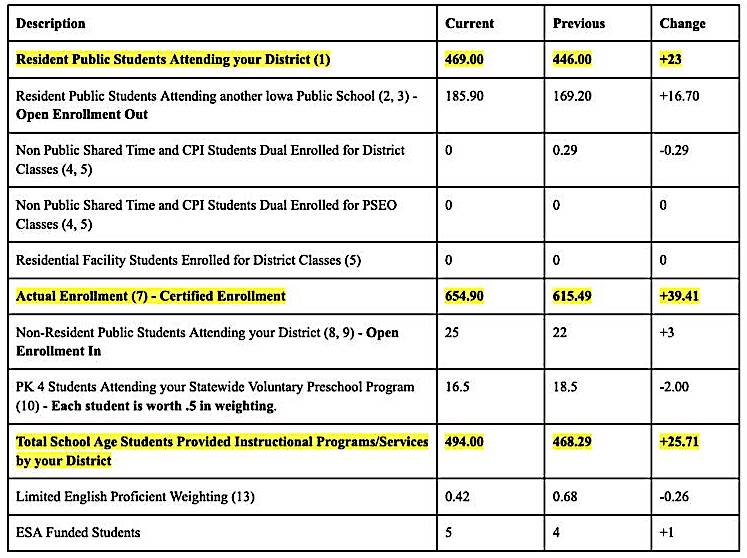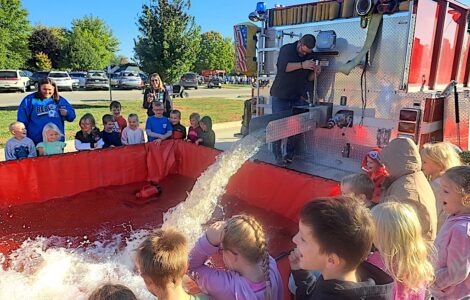G-R superintendent speaks out on ‘misleading information and’ ‘half-truths’ ahead of bond referendum
- Caleb Bonjour.
- Gladbrook-Reinbeck Community School District’s “current enrollment numbers for this year,” shared as part of Superintendent Caleb Bonjour’s Oct. 13, 2025 “District Response to Misleading Information and Social Media Posts.” CHART COURTESY OF CALEB BONJOUR

Caleb Bonjour.
REINBECK – Late this past Monday evening (Oct. 13), Gladbrook-Reinbeck Community School District Superintendent Caleb Bonjour posted to the district’s Facebook page a lengthy “District Response to Misleading Information and Social Media Posts” in an effort to address what he characterized as “half-truths” circulating on social media and in the community ahead of the upcoming Tuesday, Nov. 4, 2025 bond referendum.
“Transparency isn’t always easy, but it’s part of who we are,” Bonjour posted as an introduction to the response letter. “More than anything, I want to say this: the kids are what keep me and so many other Rebels going. The students who show up every day wearing blue, white, and gray with pride. They rise above the noise, lead with heart, and accomplish incredible things on the field, on the stage, and in the classroom. They remind me daily why this work matters.”
The letter addressed six “claims” purportedly being made on social media about the bond referendum alongside six “facts.” As of press time, the social media post had garnered 38 shares and roughly 20 comments. One of the shares was by Bonjour himself in which he wrote, “There are days this job weighs heavy. Days when I wish I could have been here years ago… not to point fingers or question those who came before me, but because I wish I could have helped navigate some of the decisions that still shape where we are today. Many of the challenges we face now were set in motion long before I arrived… long before many of our students were even in school. While a lot has changed for the better, some of the effects of those choices still ripple through our communities. My goal has always been to lead through that – to help us heal, rebuild, and move forward together.”
“I wish I could wave a hand and put something back in Gladbrook tomorrow. I wish I could make it easier for everyone to see what I see… a district full of heart, talent, and people who all want the same thing deep down… something we can all rally behind and be proud of.”
“But instead of focusing on what we could build together, too much time is being spent correcting misinformation, half-truths, and statements that try to paint me or this district as something we’re not. That part hurts, not because of pride, but because it takes energy away from what matters most… serving kids.”

Gladbrook-Reinbeck Community School District's "current enrollment numbers for this year," shared as part of Superintendent Caleb Bonjour's Oct. 13, 2025 "District Response to Misleading Information and Social Media Posts." CHART COURTESY OF CALEB BONJOUR
“I didn’t get into this work to divide people. I didn’t choose this role to stand in the middle of conflict. I became an educator and a superintendent because I believe schools can be the heart of a community… because I believe in the power of education to unite… and because I believe our students — the ones who walk our halls wearing rebel gear and their rebel spirit with pride — deserve our very best.”
“They’re why I keep showing up. They’re why I keep pushing forward, even when it’s hard. And they’re why I’ll keep doing everything I can to lead with honesty, care, and the hope that someday… we’ll all pull in the same direction again… for them.”
The newspaper is publishing the response letter, signed by Bonjour, in full below.
Introduction
Recent social media posts have spread misleading information and half-truths about district finances, facilities, and leadership decisions. These claims, often recycled and taken out of context, are being shared under the pretense of “accountability.”
Public oversight is both valuable and necessary in public education. However, when partial data, misinterpreted accounting procedures, or out-of-context remarks are used to cast doubt on integrity, it becomes damaging to the district and misleading to taxpayers.
Each time these inaccuracies are posted, hours of administrative time are spent fact-checking, compiling documentation, and clarifying information that has already been addressed. That is time and taxpayer money diverted away from serving students, improving schools, and advancing district goals.
Our intent in providing this response is not to compare ourselves to other districts or claim to have done more than anyone else. We recognize that every school system works hard to serve its community transparently. What we can speak to is our own commitment: Gladbrook-Reinbeck has consistently worked to communicate clearly, share accurate information, and invite community dialogue. Transparency is not always easy, and it often opens the door for misinterpretation, but it remains essential to who we are.
The following clarifications are shared in that same spirit of openness to ensure that facts, not speculation, guide the conversation about our schools.
1) Bond & Facility Scope
Claim: The bond proposal does not address all of the district’s long-term facility needs, meaning taxpayers will face additional projects and costs in the future. It also appears that the district intends to move forward with HVAC projects whether the bond passes or not.
Fact: These claims are misleading because they remove critical context about the district’s phased, responsible planning and about the necessity of maintaining part of the existing 1921 building.
The $17.3 million General Obligation Bond proposal focuses on replacing the district’s oldest and most urgent systems and needs including HVAC, electrical, ADA compliance, and safety improvements while adding new learning spaces that meet current needs. It does not include demolition or a complete replacement of the 1921 structure, because doing so would require a much larger bond and a higher tax burden than what is being proposed today.
The district’s approach is phased and fiscally responsible. It addresses what must be done now while maintaining flexibility for future planning when enrollment, capacity, and community readiness align. The intent is not to avoid future work, but to ensure that today’s investment solves the problems that can no longer wait.
The comment that HVAC work will continue regardless of whether the bond passes has been repeatedly taken out of context. What was stated and remains true is that the 1921 heating system must be replaced in some capacity because it has reached the end of its life.
-If the bond passes, the HVAC system for the remaining use of the 1921 building will be strategically addressed to ensure that systems are stronger, efficient, and reliable.
-If the bond does not pass, the district will still need to pursue an interim solution to ensure safe heating and ventilation for the parts of the 1921 building that will remain in full use.
That reality does not reflect defiance or waste; it reflects responsible maintenance of facilities that are still essential to our operations. The lower gym, auditorium, and other spaces will continue to serve students and the community for years to come, and they require functional systems until long-term replacement becomes financially possible.
A useful comparison is that of a farming operation. Right now, our district is operating with the equivalent of a 1921 Waterloo Boy John Deere tractor. It still runs, but it’s outdated and inefficient. This bond allows us to purchase a modern tractor to handle today’s workload safely and effectively. Will we still need to use the Waterloo Boy for some jobs? Yes, because it still serves a purpose. In the future, when the timing and resources are right, we would love to fully replace that old tractor with equipment designed for the next generation. Speculating now about what that will look like does nothing to fix what is broken today.
As one of our task force members recently said, this project is also like planting trees. We may not immediately benefit from the shade they will provide or the fruit they will bear, but we plant them anyway because it’s about forward thinking, stewardship, and investing in future generations.
This bond proposal does not attempt to solve every future challenge in one step. It solves what cannot wait, in a way that respects taxpayers, preserves flexibility for future decisions, and keeps the district moving forward responsibly.
2) Special Election Costs
Claim: The Superintendent misled the public about the cost of holding a special election.
Fact: Misrepresented and out of context.
During a public town-hall Q&A, a community member asked about special election costs. Without invoices in hand, I stated “a couple thousand,” knowing the total was under $10,000. The actual cost, approximately $8,800, includes county auditor fees, publication costs, ballot printing, and required staffing.
That answer was an informal estimate, not a formal financial report. Within a $10+ million annual budget, the distinction is immaterial, but the allegation of dishonesty is not. All expenses are publicly listed and board-approved.
3) PPEL Fund & Accounting Misrepresentation
Claim: The district used General Fund dollars for PPEL-eligible projects.
Fact: False and based on misunderstanding of school finance.
The district maintains three active bank accounts: General, Nutrition, and Activity. Within those accounts, all expenditures are tracked by state-mandated fund codes such as General, SAVE, and PPEL.
Payments may be issued from the General account for efficiency, but each expenditure is coded to its legal funding source. When a reclassification is needed, it is completed through a journal entry that is reviewed and verified by the district’s independent auditor as part of the annual audit process.
This practice is standard across Iowa school districts.
-PPEL funds are being used exactly as intended for infrastructure, maintenance, and equipment.
-No misappropriation of General Fund dollars has occurred.
-Every transaction is publicly reported, board-approved, and audited annually.
Suggesting mismanagement based on partial snapshots of the accounting system is inaccurate and misleading.
4) Enrollment, Tax, and Revenue Questions
Claim: District leadership cannot answer basic financial or enrollment questions.
Fact: False.
Figures such as certified enrollment, valuations, and revenue projections are verified through state systems (SRI, BEDS, and county-auditor data). These numbers are not static and can change during the certification process.
District leaders often choose to verify data before answering publicly to ensure accuracy over immediacy. That is a reflection of integrity, not avoidance.
At a recent town hall, when asked by an audience member about the specific increase associated with the new voted PPEL, I shared that I wanted to look up the exact numbers through the Iowa Department of Management rather than provide an estimate. Accuracy matters when discussing school finance, and it is better to take a moment to verify information than to make an educated guess that could later prove misleading.
Unfortunately, this was immediately followed by a Google search that pulled up a combined total of board-approved and voter-approved PPEL funding, which was then used to make a misleading claim. At the end of the evening, when I was able to access the official Department of Management website on my computer, I provided the factual and accurate numbers directly from the state’s records to clarify the confusion.
All verified data are shared through board packets, audits, and public records. Every financial and enrollment report is subject to review by independent auditors and the Iowa Department of Education.
For context and transparency. We are certifying some state reports this week. Below are our current enrollment numbers for this year. [Editor’s Note: The chart shared in the letter is printed as part of this article.]
As you can see above, enrollment this year is strong as we are seeing growth beyond what our projections have indicated and that we have shared previously.
I will always share as up to date and accurate information as possible, but will also want to confirm with updated data as opposed to providing estimates or guesses as these are often then taken out of context or used against myself or the district like the question on the cost of a special election.
5) Transparency & Accountability
Claim: The district hides or manipulates information.
Fact: Untrue.
Gladbrook-Reinbeck is deeply committed to keeping the community informed and ensuring that decisions are made openly and transparently. Over the past year, the district has taken deliberate steps to make information accessible and easy to understand, including:
-A comprehensive referendum/facilities specific website with project details, cost breakdowns, and timelines.
-Multiple public forums and town halls with open Q&A opportunities.
-Board packets, minutes, and budgets consistently posted online.
-Public mailers, newsletters, and direct responses to community inquiries.
-All claims, expenditures, and reports approved in public meetings and verified through annual
audits.
These efforts reflect a genuine belief that transparency builds trust. Our goal has never been to outdo anyone else, but to do right by our community- to share information clearly, answer questions honestly, and invite conversation about the challenges and opportunities facing our schools.
Transparency naturally invites more questions and, at times, misinterpretation, but that is part of healthy public dialogue. What should never happen, however, is for transparency to be weaponized to distort facts or create distrust.
Every hour spent refuting misinformation is an hour not spent supporting students, teachers, and staff. Gladbrook-Reinbeck remains committed to openness, accountability, and constructive communication that keeps our focus where it belongs: on learning and community growth.
With this said, mistakes may be made. When mistakes happen we will do our absolute best to rectify any mistake and ensure that they are corrected timely and in accordance with policy and corrective actions outlined by Iowa code, and in consultation with any governing body that is involved, and as advised by district legal counsel.
6) Consolidation, Tax Rates, and Long-Term Impact
Claim: If the bond fails, the district could simply consolidate with a neighboring district to avoid new costs.
Fact: That assumption ignores both the financial and facility realities of consolidation.
Gladbrook-Reinbeck currently has one of the lowest school tax rates in the area, $11.19 per $1,000 of taxable valuation, and even if the bond passes, the rate would rise only to $13.89. This remains below or competitive with neighboring districts such as Grundy Center ($14.79), Dike-New Hartford ($14.79), GMG ($15.85), and Hudson ($16.69).
If consolidation occurred, taxpayers would not retain Gladbrook-Reinbeck’s lower rate. Combined district levies are typically recalculated toward the higher district’s rate, meaning G-R residents would likely experience a permanent tax increase, not a savings.
Moreover, most neighboring districts already operate at or near capacity. Absorbing G-R students would immediately strain classrooms, transportation, and staffing. To accommodate additional enrollment, those districts would likely need new facility projects or bond referendums, increasing taxes for everyone involved.
In short:
-Consolidation does not necessarily save money; it shifts funds and can increase costs
-It would remove local control over tax and facility decisions.
-It would likely raise tax rates for our current district tax payers and delay the improvements our
students need today.
Passing this bond allows our community to address critical facility needs responsibly while maintaining one of the lowest tax rates in the region and ensuring local taxpayers remain in control of their investment.
In addition to these long-term considerations, it is important to note that school tax rates are not fixed. Each year, districts set their levies through a state-certified budgeting process that includes multiple components such as the cash reserve levy, management levy, and PPEL, as well as income surtax adjustments. These tools allow districts to manage overall taxpayer impact while maintaining essential programs and facility upkeep.
Gladbrook-Reinbeck regularly reviews these elements to ensure fiscal responsibility and stability. The district’s ability to decrease or adjust the PPEL levy in coming years will depend significantly on whether the bond passes, since the outcome directly affects which facility costs must continue to be funded through other levies. The same goes for how to handle the income surtax portion of this as the district has not increased this part in years and could do so, resulting in a lower property tax rate.
Closing Statement
The continued spread of misleading information and distortion of facts is harmful to taxpayers, staff, and students alike. Gladbrook-Reinbeck will continue to operate with transparency, accuracy, and integrity, and will not allow other narratives to define the district’s work or distract from its mission.
We are proud of our commitment to honesty, accountability, and fiscal responsibility, and we will continue to ensure that every decision and every dollar serves the students and communities of the Gladbrook-Reinbeck Community School District.
At the end of the day, the group that makes me most proud – and the reason I continue doing what I do: our students. The kids who wear blue, white, and gray with pride. The ones who show up every day, tune out the noise, and continue accomplishing phenomenal things in and out of the classroom, on the field, court, and stage. They are why we exist. Their perseverance, character, and spirit remind us what matters most and why this work is worth doing.
For some of our students, this type of tension within the community has existed for as long as they’ve been in school. Yet they continue to rise above it, representing Gladbrook-Reinbeck with class, unity, and resilience. They deserve our collective commitment to move forward, together, in a way that honors their future and the generations who will follow them.




